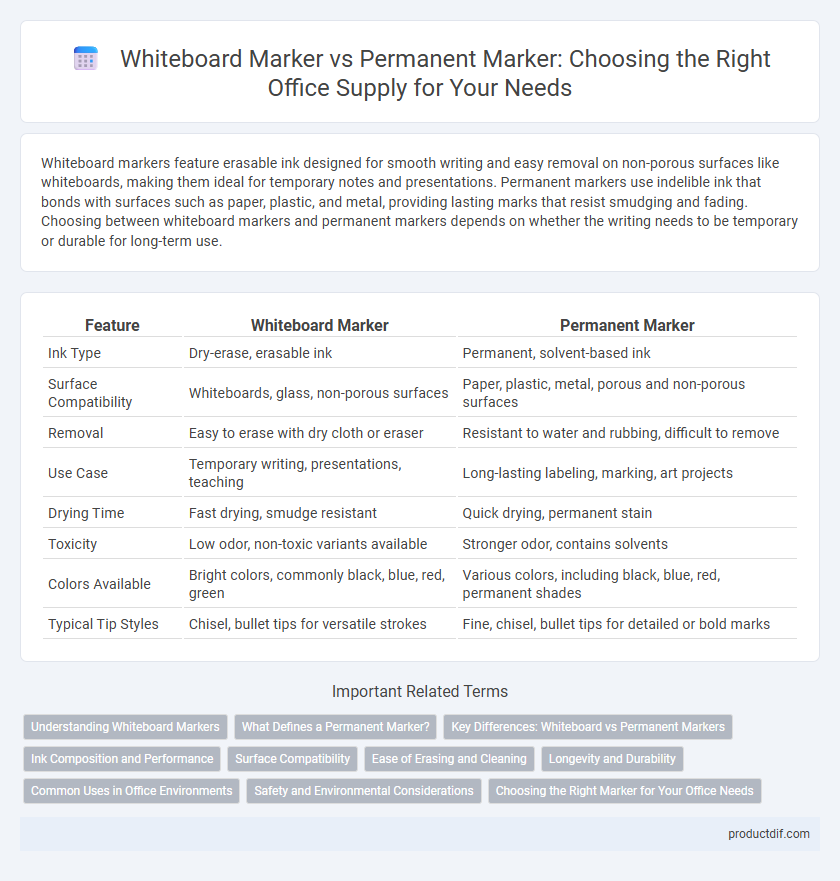Whiteboard markers feature erasable ink designed for smooth writing and easy removal on non-porous surfaces like whiteboards, making them ideal for temporary notes and presentations. Permanent markers use indelible ink that bonds with surfaces such as paper, plastic, and metal, providing lasting marks that resist smudging and fading. Choosing between whiteboard markers and permanent markers depends on whether the writing needs to be temporary or durable for long-term use.
Table of Comparison
| Feature | Whiteboard Marker | Permanent Marker |
|---|---|---|
| Ink Type | Dry-erase, erasable ink | Permanent, solvent-based ink |
| Surface Compatibility | Whiteboards, glass, non-porous surfaces | Paper, plastic, metal, porous and non-porous surfaces |
| Removal | Easy to erase with dry cloth or eraser | Resistant to water and rubbing, difficult to remove |
| Use Case | Temporary writing, presentations, teaching | Long-lasting labeling, marking, art projects |
| Drying Time | Fast drying, smudge resistant | Quick drying, permanent stain |
| Toxicity | Low odor, non-toxic variants available | Stronger odor, contains solvents |
| Colors Available | Bright colors, commonly black, blue, red, green | Various colors, including black, blue, red, permanent shades |
| Typical Tip Styles | Chisel, bullet tips for versatile strokes | Fine, chisel, bullet tips for detailed or bold marks |
Understanding Whiteboard Markers
Whiteboard markers use water-based ink designed for easy erasure on non-porous surfaces like whiteboards, ensuring smooth writing and clean removal without staining. Unlike permanent markers, their pigments do not soak into surfaces, preventing ghosting and residue buildup after multiple uses. Choosing the right whiteboard marker involves considering tip size, ink vibrancy, and low-odor formulas for optimal visibility and user comfort during presentations or planning sessions.
What Defines a Permanent Marker?
A permanent marker is defined by its quick-drying, ink composition that adheres strongly to a variety of surfaces, including plastic, metal, and glass, making it ideal for long-lasting marks. Unlike whiteboard markers, the ink in permanent markers is resistant to water, smudging, and fading, ensuring durability and permanence. These markers contain solvent-based inks that penetrate surfaces, providing vibrant, bold lines that are not easily erased.
Key Differences: Whiteboard vs Permanent Markers
Whiteboard markers, designed with erasable ink, use non-permanent pigments ideal for smooth, glossy surfaces like whiteboards, allowing easy removal without residue. Permanent markers contain solvent-based ink that bonds to surfaces such as paper, metal, and plastic, creating long-lasting, water-resistant marks that are difficult to erase. Choosing between these markers depends on the need for temporary versus permanent writing, with whiteboard markers suited for repeated use and permanent markers for lasting identification or labeling.
Ink Composition and Performance
Whiteboard markers use an alcohol-based ink that is designed to be easily erasable from non-porous surfaces without leaving residue, featuring pigments suspended in a quick-drying solvent for smooth writing. Permanent markers contain oil or solvent-based inks with synthetic resins, providing water-resistant and fade-proof markings on various surfaces, but their ink is difficult to remove. The performance of whiteboard markers excels in temporary writing tasks on whiteboards, while permanent markers are ideal for labeling and marking materials requiring long-lasting durability.
Surface Compatibility
Whiteboard markers are specially formulated for non-porous surfaces like glass, whiteboards, and laminated sheets, allowing easy erasure without leaving residue. Permanent markers are designed to adhere to a broader range of materials including plastic, metal, and paper, creating long-lasting, smudge-proof marks. Using a whiteboard marker on porous surfaces or with permanent markers on whiteboards risks surface damage or staining.
Ease of Erasing and Cleaning
Whiteboard markers are designed with erasable ink that easily wipes off non-porous surfaces using a dry cloth or whiteboard eraser, making them ideal for frequent updates and cleanings. In contrast, permanent markers contain solvent-based ink that bonds strongly to surfaces, requiring alcohol-based cleaners or solvents for removal and often leaving stains or ghosting. Choosing between these markers depends on the ease of erasing needed, with whiteboard markers providing hassle-free cleaning on whiteboards, while permanent markers are suited for long-lasting marks on various materials.
Longevity and Durability
Whiteboard markers feature erasable ink designed for temporary use on non-porous surfaces, offering moderate longevity limited to a few days before fading or smudging. Permanent markers utilize durable, solvent-based ink that bonds with various surfaces, ensuring long-lasting, water-resistant, and fade-proof marks ideal for labeling and heavy-duty applications. Choosing between whiteboard and permanent markers depends on whether temporary clarity or enduring durability is required for specific office tasks.
Common Uses in Office Environments
Whiteboard markers are commonly used for temporary writing on dry-erase boards, making them ideal for meetings, presentations, and brainstorming sessions where erasing and updating content is frequent. Permanent markers are preferred for labeling files, folders, and equipment due to their long-lasting, smudge-proof ink that adheres to various surfaces such as plastic, metal, and cardboard. Using the correct marker type enhances organization and communication efficiency within office environments.
Safety and Environmental Considerations
Whiteboard markers use non-toxic, low-odor ink designed for easy erasability, minimizing health risks and reducing environmental impact compared to permanent markers, which contain stronger solvents that can emit harmful fumes and are less eco-friendly due to their durability and disposal challenges. Choosing whiteboard markers often supports safer indoor air quality and facilitates recycling or safer waste management, while permanent markers require cautious use and disposal to prevent chemical exposure and environmental contamination. Prioritizing non-toxic materials and biodegradability in marker selection significantly enhances workplace safety and sustainability.
Choosing the Right Marker for Your Office Needs
Whiteboard markers feature erasable ink ideal for temporary notes and presentations on non-porous surfaces, while permanent markers use indelible ink suited for labeling and long-lasting marks on various materials. Selecting the right marker depends on office tasks: whiteboard markers support collaborative brainstorming with easy removability, whereas permanent markers provide durability for files, equipment, and packaging. Opt for low-odor, quick-drying formulas in either category to enhance workplace comfort and productivity.
Whiteboard Marker vs Permanent Marker Infographic

 productdif.com
productdif.com